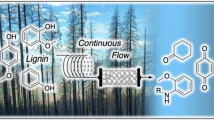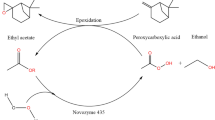Abstract
Resveratrol is a natural bioactive non-flavonoid polyphenol that protects from cardiovascular disease, neurodegenerative diseases and various cancers. Unfortunately, the amounts of resveratrol in plants are low and therefore, chemical synthesis is still the main way to obtain this valuable structure. In this work, Wittig reaction was chosen as the synthetic route for the study on technology influence in batch vs. micro- or milliflow reactors during the production of new resveratrol-like compounds. A series of reactions was carried out by batch synthesis, and intensified in a milli- and a microreactor, changing the reaction conditions to increase the efficiency and productivity of the process. Results were compared based on conversion, yield, productivity and trans/cis ratio. Similar yields and conversions were obtained in all reaction systems, but in much shorter time in the milli- and microscale compared to the batch reactor. On the other hand, higher productivities were obtained in the millireactor and microreactor, making them better systems for the proposed reactions of new heterocyclic resveratrol analogues synthesis.
Graphical abstract












Similar content being viewed by others
References
Belwal T, Nabavi SM, Nabavi SF, Dehpour AR, Shirooie S (2020) Naturally occurring chemicals against Alzheimer’s Disease. Academic, London. https://doi.org/10.1016/C2018-0-03965-1
Anekonda TS (2006) Brain Res Rev 52(2):316–326. https://doi.org/10.1016/j.brainresrev.2006.04.004
Anekonda TS, Wadsworth TL, Sabin R, Frahler K, Harris C, Petriko B, Ralle M, Woltjer R, Quinn JF (2011) J Alzheimers Dis 23:21–35. https://doi.org/10.3233/JAD-2010-101287
Li J, Qiu Z, Zhao GR (2022) Synth Syst Biotechnol 7:718–729. https://doi.org/10.1016/j.synbio.2022.03.001
Lopez-Hernandez J, Paseiro-Losada P, Sanches-Silva AT, Lage-Yusty MA (2007) Eur Food Res Technol 225:789–796. https://doi.org/10.1007/s00217-006-0483-x
Montsko G, Nikfardjam MSP, Szabo Z, Boddi K, Lorand T, Ohmacht R, Mark L (2008) J Photochem Photobiol A 196:44–50. https://doi.org/10.1039/c2pp25239b
Silva CG, Monteiro J, Marques RRN, Silva AMT, Martínez C, Canle M, Faria JL (2013) Photochem Photobiol Sci 12:638. https://doi.org/10.1039/c2pp25239b
Cottart CH, Nivet-Antoine C, Laguillier-Morizot C, Beaudeux JL (2010) Mol Nutr Food Res 54:7–16. https://doi.org/10.1002/mnfr.200900437
Klaus WL, Shiming L (2018) BioFactors 44:83–90. https://doi.org/10.1002/biof.1396
Roupe KA, Remsberg CM, Yáñez JA, Davies NM (2006) Curr Clin Pharmacol 1:81–101. https://doi.org/10.2174/157488406775268246
Lin HS, Yue BD, Ho PC (2009) Biomed Chromatogr 23:1308–1315. https://doi.org/10.1002/bmc.1254
McCormack D, McFadden D (2013) Oxid Med Cell Longev 2013:575482. https://doi.org/10.1155/2013/575482
Bertelli AAE, Giovanni L, Stradi R, Bertelli A, Tillement JP (1996) Int J Tissue React 18:67–71. https://doi.org/10.4172/2155-9880.1000216
Burns J, Yokota T, Ashihara H, Lean MEJ, Crozier A (2002) J Agric Food Chem 50:3337–3340. https://doi.org/10.1021/jf0112973
Ratola N, Faria JL, Alves A (2004) Food Technol Biotechnol 42:125–130
Šinkovec E, Krajnc M (2011) Org Process Res Dev 15:817–823. https://doi.org/10.1021/op200061j
Okamoto H, Takahashi H, Takane T, Nishiyama Y, Kakiuchi K, Gohda S, Yamaji M (2017) Synthesis 49:2949–2957. https://doi.org/10.1055/s-0036-1588775
Gerardy R, Emmanuel N, Toupy T, Kassin V-E, Tshibalzona NN, Schmitz M, Monbaliu J-CM (2018) Eur J Org Chem 2018:2301–2351. https://doi.org/10.1002/ejoc.201800149
Baumann M, Moody TS, Smyth M, Wharry S (2020) Org Process Res Dev 24:1802–1813. https://doi.org/10.1021/acs.oprd.9b00524
Bloemendal VRLJ, Janssen MACH, van Hest JCM, Rutjes FPJT (2020) React Chem Eng 5:1186–1197. https://doi.org/10.1039/D0RE00087F
Plutschack MB, Pieber B, Gilmore K, Seeberger PH (2017) Chem Rev 117:11796–11893. https://doi.org/10.1021/asc.chemrev.7b00183
Wegner J, Ceylan S, Kirschning A (2011) Chem Commun 47:4583–4592. https://doi.org/10.1039/C0CC05060A
Geyer K, Codee JDC, Seeberger PH (2006) Chem Eur J 12:8434. https://doi.org/10.1002/chem.200600596
Mlakić M, Šalić A, Bačić M, Zelić B, Šagud I, Horváth O, Škorić I (2021) Catalysts 11:395. https://doi.org/10.3390/catal11030395
Horspool WM, Song PS (1995) CRC Handbook of Organic Photochemistry and Photobiology, Boca Raton
Griesbeck A, Oelgemӧller M, Ghetti F (2012) CRC Handbook of Organic Photochemistry and Photobiology, Boca Raton
Gingerich SB, Jennings PW (1983) J Org Chem 48:2606. https://doi.org/10.1021/jo00163a039
Gülçin I (2010) Innov Food Sci Emerg Technol 11:210–218. https://doi.org/10.1016/j.ifset.2009.07.002
Fauconneau B, Waffo-Teguo P, Huguet F, Barrier L, Decendit A, Merillon JM (1997) Life Sci 61:2103–2110. https://doi.org/10.1016/s0024-3205(97)00883-7
Orallo F (2006) Curr Med Chem 13:87–98
Francioso A, Mastromarino P, Masci A, d’Erme M, Mosca L (2014) Med Chem 10:237–245. https://doi.org/10.2174/15734064113096660053
Kulkarni SS, Canto C (2015) Biochim Biophys Acta 1852:1114–1123. https://doi.org/10.1016/j.bbadis.2014.10.005
Brand-Williams W, Cuvelier ME, Berset C (1995) LWT - Food Sci Technol 28:25–30. https://doi.org/10.1016/S0023-6438(95)80008-5
Acknowledgements
This work was supported by grants from the University of Zagreb short term scientific support for 2021 under the title Synthesis and photochemistry of various new heterostilbene derivatives. We acknowledge the NMR Centre at Ruđer Bošković Institute and the competent help by Željko Marinić for recording all the NMR spectra.
Author information
Authors and Affiliations
Corresponding authors
Ethics declarations
Ethical approval
This article does not contain any studies with human participants or animals performed by any of the authors.
Informed consent
Informed consent not applicable.
Conflict of interest
All authors certify that they have no affiliations with or involvement in any organization or entity with any financial interest or non-financial interest in the subject matter or materials discussed in this manuscript. All Author declare that they have no conflict of interest.
Additional information
Publisher’s Note
Springer Nature remains neutral with regard to jurisdictional claims in published maps and institutional affiliations.
Supplementary Information
Below is the link to the electronic supplementary material.
ESM 1
(DOCX 442 KB)
Rights and permissions
Springer Nature or its licensor holds exclusive rights to this article under a publishing agreement with the author(s) or other rightsholder(s); author self-archiving of the accepted manuscript version of this article is solely governed by the terms of such publishing agreement and applicable law.
About this article
Cite this article
Mlakić, M., Rajič, L., Ljubić, A. et al. Synthesis of new heterocyclic resveratrol analogues in milli- and microreactors: intensification of the Wittig reaction. J Flow Chem 12, 429–440 (2022). https://doi.org/10.1007/s41981-022-00239-9
Received:
Accepted:
Published:
Issue Date:
DOI: https://doi.org/10.1007/s41981-022-00239-9




